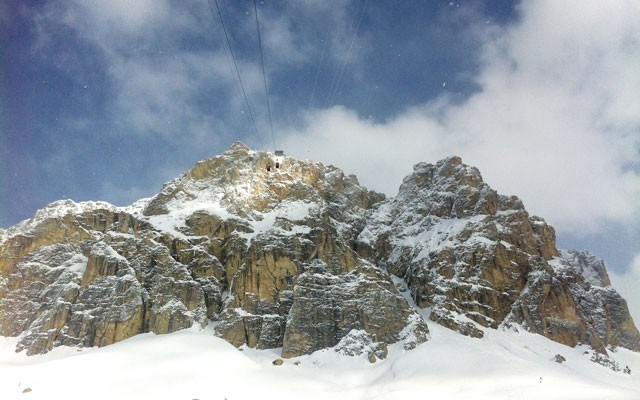Children living in snowy places dream of storms that will bring a day off school.In Cortina d'Ampezzo in the Italian Dolomites — the centre of Dolomiti Superski, the world's largest ski domain with 12 ski areas, 450 lifts, and 1,200 kilometres of pistes linked by a single ticket — almost 20 metres of snow fell last winter, and schools closed for a week because parents were worried their kids might be hit by snow calving off of the glacier-like roofs above them. With the alpine zones on the mountains mostly shuttered during a series of mega storms, the valley's guides had no one to guide and found themselves platooning up to work double-time cleaning off roofs and digging out cars. Some say it was the most snow they'd seen in 50 years. Since no one keeps records of such things in Italy, let's just say it had been a while since the good folks of Cortina had seen anything like it — and more than a while since skiers had enjoyed such a bounty in a place traditionally known for sunny, wide-open cruising, fur coats and small dogs. Though last winter was anything but normal in Cortina, it certainly didn't disappoint — least of all those who set to dealing with it in a style reminiscent of military precision.
The towering peaks of the Italian Dolomites rise above the surrounding countryside like so many limestone fortresses. When you dig a bit into their history, it turns out many of them were actually used for just this.
You could go pretty far back in time to chart the many times this ragged range stood in the way of one invader or another, serving the purposes of defense for those who occupied the area. The most interesting chapter in these chronicles of conflict, however, occurred during the First World War, when Italy joined in the fight against the aggressors of the Austro-Hungarian empire in 1915.
Mountains figure into war and other battles because of the notion that higher ground is advantageous for many reasons — not least of which is that it's easier to defend (provided you have the resources for a prolonged siege). War and skiing don't seem like good bedfellows, but at times are quite intertwined: for instance, those folks who conducted mountain warfare in the Alps for the U.S. in the Second World War as part of the vaunted 10th Mountain Division went back home to seed the very robust U.S. ski industry by starting a dozen famous resorts and ski schools, and without them and the passion for the mountains developed as soldiers, things would have progressed a lot differently. Though I have no idea of their eventual influence on the sport one way or another, the Dolomites saw their first skiing troops long before that.
Though the First World War was fought all over the Dolomites, one peak in particular — Piccolo Lagazuoi — became the scene of a unique battle known as the "war of the mines." Once the surrounding peaks were all captured and held, the war went underground on the peak where the frontline lay — Lagazuoi. Here, the Italian and Austrian troops dug extensive cave and tunnel systems through the considerable limestone ramparts of Lagazuoi's 600-metre face, creating a network from which they could not only overlook and defend the frontlines, but also blow up the enemy from below. Five enormous mines — their chambers packed with up to 32,000 kilograms of explosives — exploded within this mountain over the course of the conflict, leaving their indelible marks for all to see. Amazingly, nothing was accomplished militarily by all of this, and the armistice that ended the war was declared shortly after the last fruitless explosion in 1917. The tunnels have recently undergone major reconstruction, and so, although there wasn't much to fight about in Cortina last winter unless you were a snowplow operator, you could still experience the tunnels as an open-air museum. Skiing to, and walking through them was an experience not to be missed.
While staying a couple of nights atop Lagazuoi at 2,800 metres in the quite agreeable Rifugio Lagazuoi with Mike Douglas and a Salomon Freeski TV film crew last winter, we all had the chance to check out the tunnel system. From the top you could ski off the back down the long route of Armentarola toward Alta Badia, or wrap around the front on the Lagazuoi museum route as I did while the rest of the guys were filming. It was impressive, with many of the gun placements occupying lookouts through dizzying portals on the mountain face. Afterward, making a run to the valley, I cut in under the face onto the mountain's flanks to have a look back up at this improbable vertical battlefield. I had to side-hill from one compass point of the monolith to another before I could begin a descent through the 50 centimetres of angel-feather powder that blanketed the meadow above the tram station, but it was worth it both for the view and the pow. Later, on an old map, I noticed that I had started my traverse just above where the Italian trenches had been and crossed completely to the equivalent Austrian positions, a distance of a mere half a kilometre. They fought close in those days. Since the troops were up there in winter, some of them were surely equipped with skis. I wondered if they thought about making a few turns while they were languishing at their icy stations in the mountains? I know I would have.
The schools may have been closed a lot in Cortina last winter, but history was still being taught all over the Dolomites
You can check out the Salomon Freeski TV episode "War Story" at: www.youtube.com/watch?v=hD1hrF4-CZU&feature=youtu.be
Leslie Anthony is a Whistler-based author, editor, biologist and bon vivant who has never met a mountain he didn't like.




